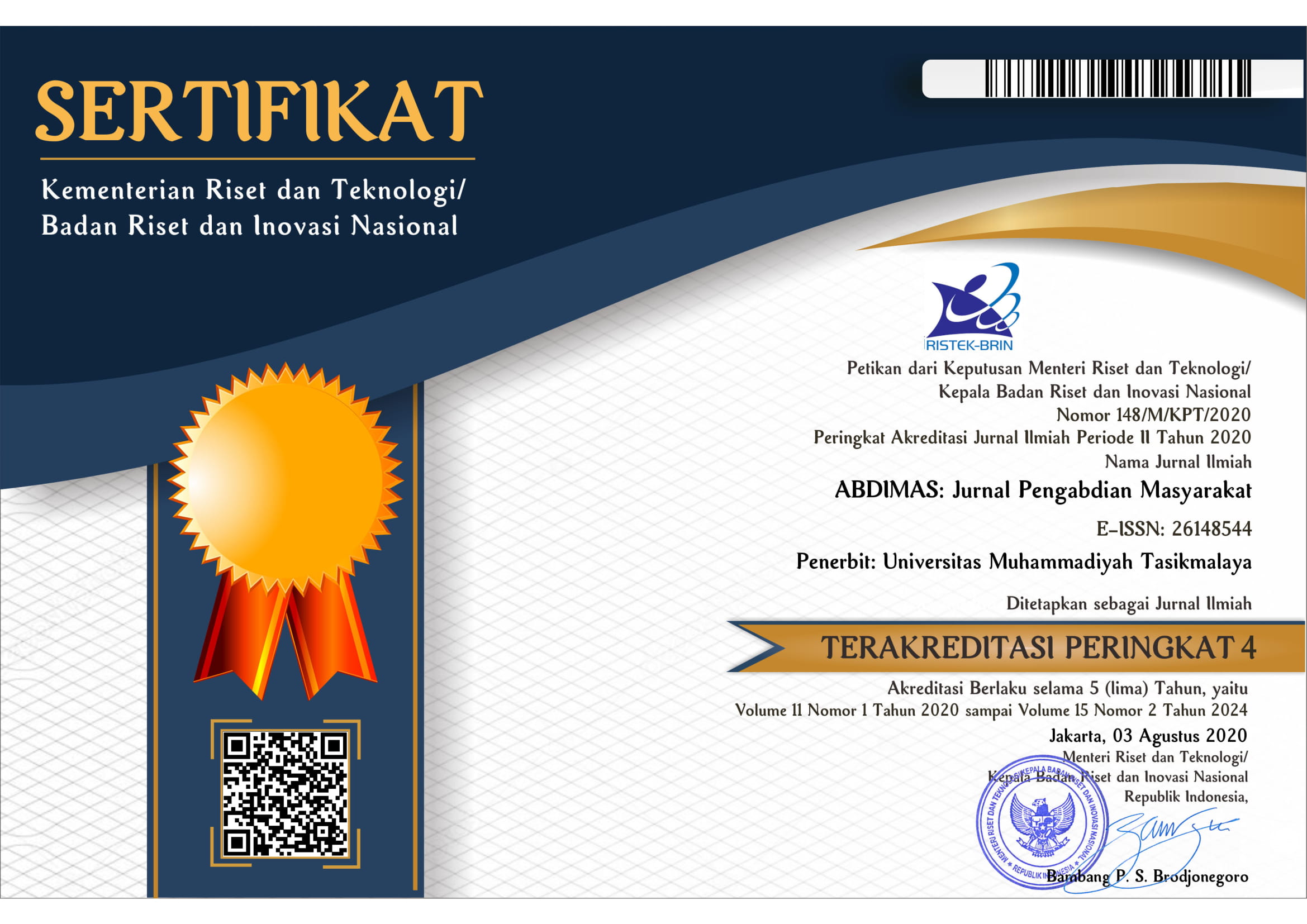Detection of Toddler Growth and Development Monitoring for Parents at Posyandu Merpati
DOI:
https://doi.org/10.35568/abdimas.v7i3.3916Keywords:
Early Detection, Toddler Growth and Development, ParentsAbstract
The Covid-19 pandemic outbreak is very detrimental to the community in the health sector, they are limited in visiting health services, there is fear and anxiety of the community to contract the Covid-19 virus. This can lead to disrupted monitoring of the growth and development of children under five in health facilities. Child development is an important thing to pay attention to because child development in the early phase will affect child development in the next phase, around 7.6 million children worldwide die before reaching the age of 5 years and more than 190 million children who live cannot reach their potential development age. The Stimulation Detection and Early Intervention of Growth and Development (SDIDTK) program is one of the main programs of the Puskesmas. The purpose of this counseling is to increase the knowledge and understanding of parents, especially mothers, regarding early detection of growth and development problems in toddlers aged 2-6 years. Health education is carried out by face-to-face method by providing counseling using leaflets, with parents who have toddlers as participants. Measurement of knowladge can be done by giving a questionnaire measuring instrument in the form of pretest and posttest. The results of health counseling activities obtained by 30 respondents showed that at the time of the pretest as many as 13 respondents (43.33%) were in the good category and as many as 17 respondents (56.67%) were in the poor category. The conclusion in the implementation of health education regarding early detection of child growth and development monitoring has an impact on increasing knowledge and understanding in parents.
Downloads
References
Esme, Yunike, Mariani, & Wibowo. (2022). Tumbuh Kembang Anak (1st ed.). PT Global Eksekutif Teknologi.
Harwijayanti, bekti putri. (2023). Tumbuh Kembang Anak. Get Press Indonesia.
Hidayat, A. A. (2020). Pengantar Ilmu Kesehatan Anak Untuk Pendidikan Kebidanan. Salemba Medika.
Islamiyati, Sadiman, & Triwijayanti, Y. (2021). Empowerment of Family in Early Detection of Total Growth at Puskesmas Karangrejo Metro. ABDIMAS UMTAS: Jurnal Pengabdian Masyarakat, 4(2).
Izah. (2022). Stimulasi Dan Deteksi Dini Tumbuh Kembang Balita Usia 9-12 Bulan Menggunakan Aplikasi Tumbuh Kembang Balita Di Wilayah Kelurahan Margadana. Jurnal Abdimas PHB, 2(2).
Kemenkes. (2020). Profil kesehatan Indonesia. Kementerian Kesehatan Republik Indonesia.
Kiftiyah, Riska, & Sabrina. (2022). Pengantar Asuhan Kebidanan. Yayasan Penerbit Muhammad Zaini.
Lie, J. S. (2021). Insreasing Paud Teacher Knowledge About Childrens Growth Detection With KPSP. ABDIMAS UMTAS: Jurnal Pengabdian Masyarakat, 4, 2.
Lubis, H. (2023). Penyuluhan Kesehatan Masyarakat Pertanian (1st ed.). Dotplus Publisher.
Melia, D., Rinjani, M., & Susanti, R. (2021). Deteksi Dini Tumbuh Kembang Anak Usia 0-6 Tahun Berbasis Aplikasi Android. Wellness And Healthy Magazine, 1(1).
Novianti, & Utami. (2022). Penilaian Status Gizi dan Pengetahuan Gizi Seimbang Anak Usia Sekolah Sebagai Bentuk Aktivasi Kegiatan UKS. ABDIMAS Jurnal Kesehatan Masyarakat, 4(1), 399–404.
Nurpratama, Lestari, W., Puspasari, K., & Rahmadanti1, A. (2023). PENYULUHAN PENTINGNYA PENIMBANGAN PADA BALITA DI POSYANDU MERPATI 3 DESA KARANG ASIH KECAMATAN CIKARANG UTARA. Jurnal Pengabdian Masyarakat Berkemajuan, 7(1).
Prastiwi. (2020). Pertumbuhan dan Perkembangan Anak Usia 3-6 Tahun. Jurnal Ilmiah Kesehatan Sandi Husada, 10(2), 242–249.
Pratiwi. (2022). Optimalisasi Peran Orang Tua Dalam Pemantauan Pertumbuhan, Perkembangan dan Stimulasi Balita Pada Masa Pandemi Covid-19. Jurnal Widya Laksana, 11(2).
Setiowati. (2020). Golden Age Parenting Periode Emas Tumbuh Kembang Anak (1st ed.). Media Nusa Creative.
Siregar, N., Syukur, N. A., & Suryani, H. (2022). Prevention of Stunting Through Cadre Empowerment in the Mangkupalas Health Center Work Area in 2021. ABDIMAS UMTAS: Jurnal Pengabdian Masyarakat, 5(1).
Suryana, D. (2021). Stimulasi dan Aspek Perkembangan Anak. Kencana.
Susilawati. (2020). Karakteristik Ibu dan Balita Dalam Pemantauan Pertumbuhan dan Perkembangan Balita. Jurnal Kebidanan, 9(2), 143–152.
Tambunan, E., & Ratnaningsih, T. (2021). Tumbuh Kembang Optimal Anak Stimulasi dan Antisipasi. Wineka Media.
UNICEF. (2021). Laporan Tahunan 2021. United Nations International Children’s Emergency Fund.
WHO. (2020). Improving Early Childhood Development. World Health Organization.














